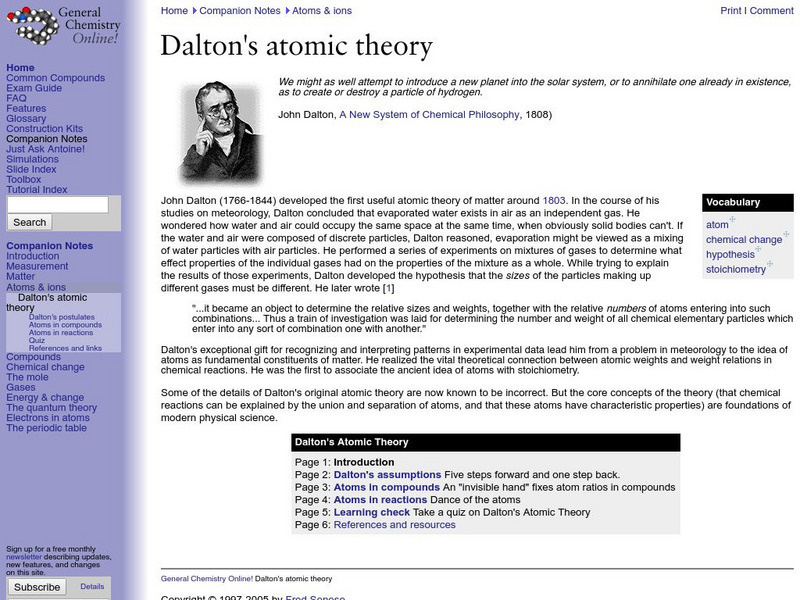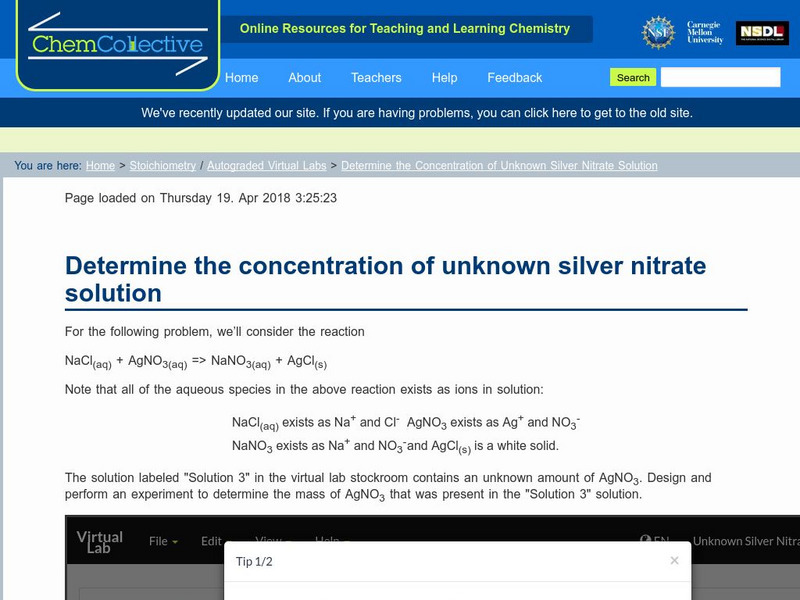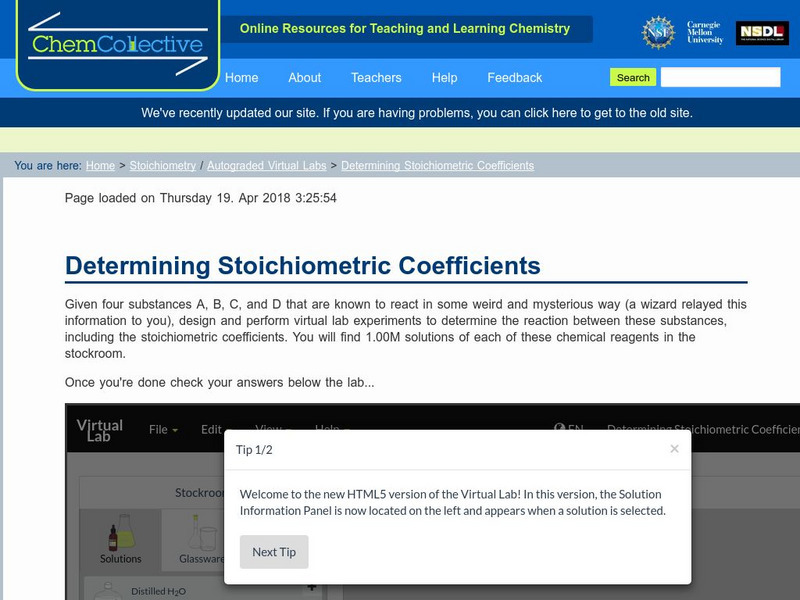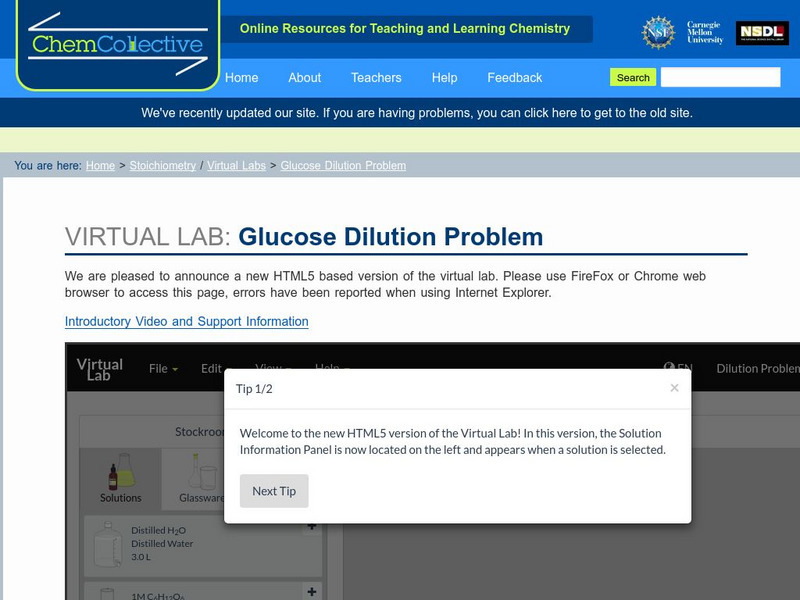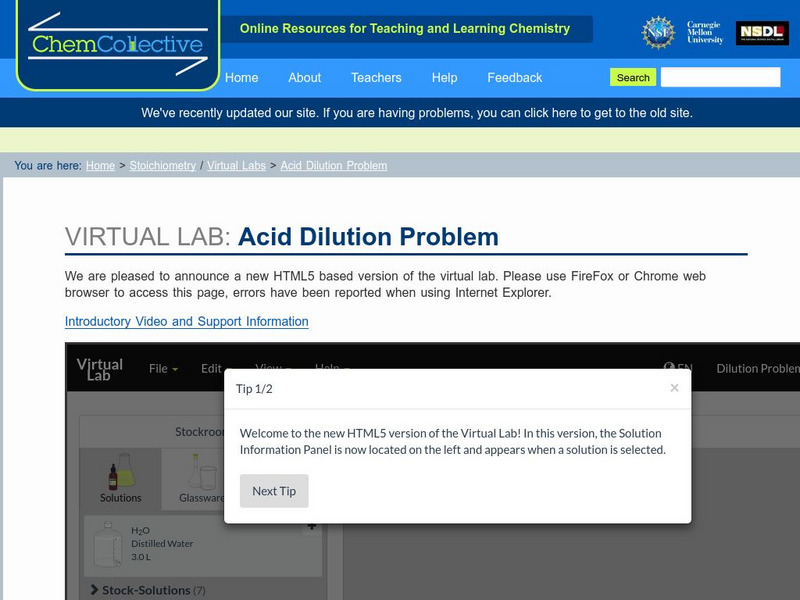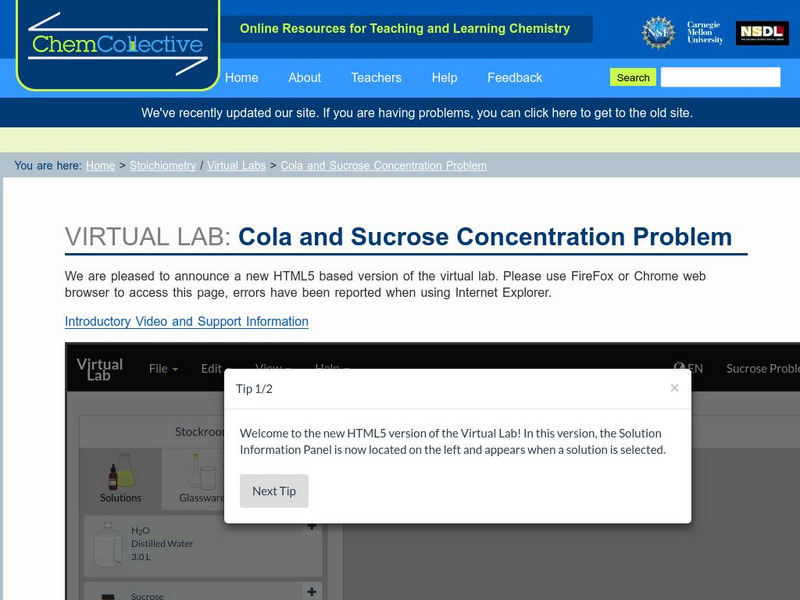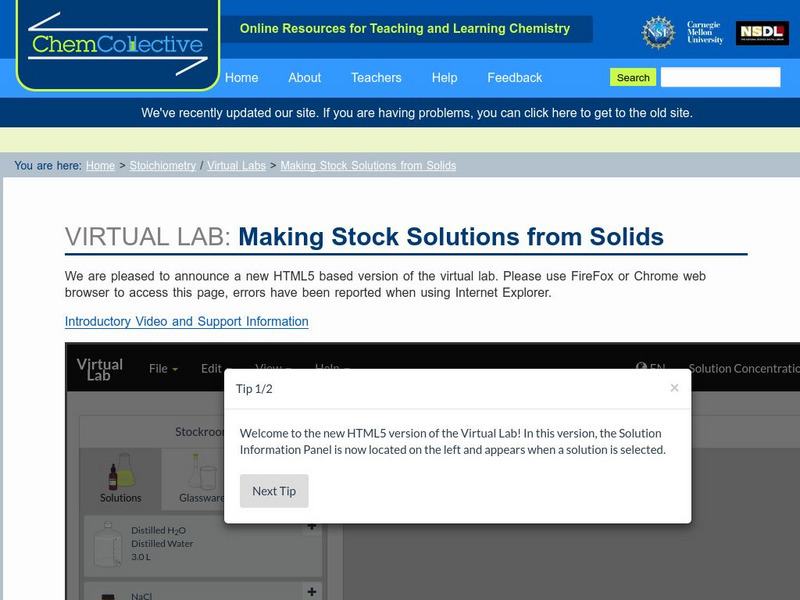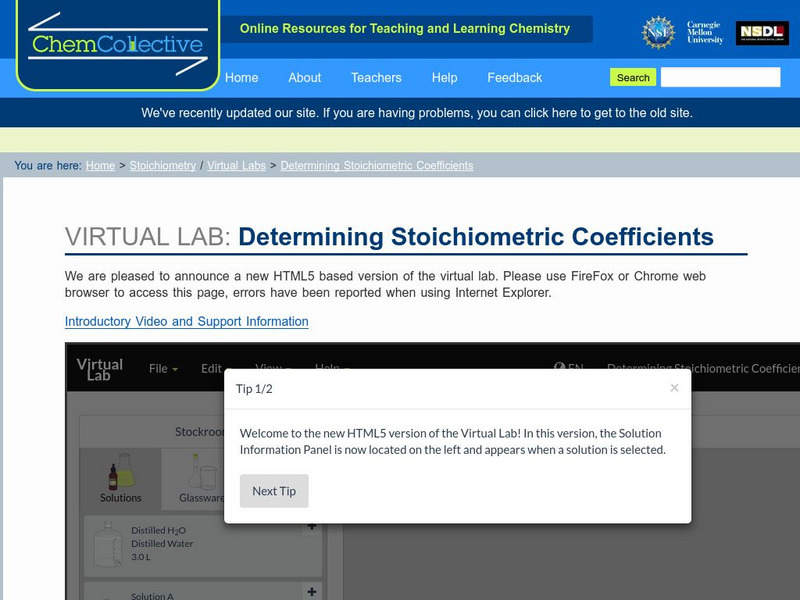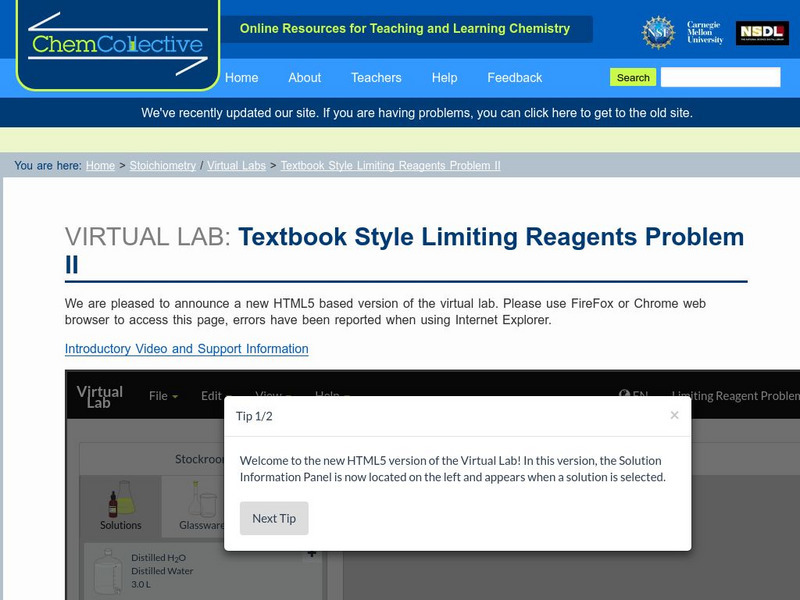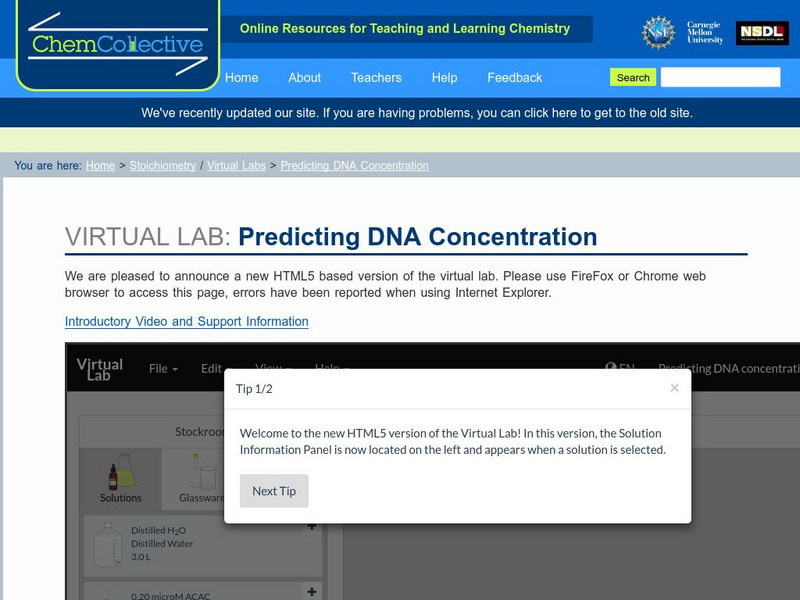Frostburg State University
General Chemistry Online: Limiting Reactant Problem
Explains the essence of limiting reactant problems using a sample problem: How can an amount of product (KNO3) be predicted from amounts for two reactants (KCl and HNO3)? Shows the work and explains how to solve these types of problems.
Chemistry Collective
Chem Collective: Mission Critical Chemistry
Students use stoichiometry and thermochemistry to design a new fuel for a mission to Mars. In this activity, students work in teams using the virtual lab to characterize a new set of oxidants and reductants that can serve as a fuel for...
Cosmo Learning
Cosmo Learning: Chemistry 1 A: General Chemistry
A collection of video lectures from a general chemistry course taught at the University of California, Berkeley. The course covers topics like stoichiometry, acid-base and solubility equilibrium, oxidation-reduction reactions, chemical...
Davidson College
Davidson College: Chemical Equilibria: Calculations With Reaction Stoichiometry
Explains the use of a reaction table when analyzing chemical equilibrium and presents a virtual experiment where the equilibrium constant of a chemical reaction is determined for different scenarios. Requires Java.
Chiral Publishing
Chiral Publishing: An Introduction to Chemistry: Gas Stoichiometry Shortcut
This section of the online book "An Introduction to Chemistry", describes a shortcut that can be used for equation stoichiometry problems that include two gases. An example calculation which shows the shortcut being used is helpful. Also...
Chem Tutor
Chem Tutor: Dissolving Gases Into Liquids
Description of the factors influencing gas solubility. This site also provides other chemistry related questions. Topics include dissolving solids into liquids, concentration, and stoichiometry.
CK-12 Foundation
Ck 12: Chemistry Simulation: Airbag
[Free Registration/Login Required] Explore how decomposition reactions are used to inflate an airbag in a car crash.
CK-12 Foundation
Ck 12: Mole Ratios
[Free Registration/Login may be required to access all resource tools.] In this online tutorial students will relate balanced chemical equations to everyday analogies, such as a recipe. They will also define stoichiometry and use mole...
Savvas Learning
Chemistry, the Central Science: Enthalpies of Formation
A section from a textbook about enthalpies of formation. Includes practice exercises, a table of enthalpy values, and examples.
Frostburg State University
General Chemistry Online: Dalton's Atomic Theory
Discusses John Dalton's development of the atomic theory and the four main points of his theory. Includes references and a link to a quiz on Dalton's Atomic theory.
Khan Academy
Khan Academy: Limiting Reagents and Percent Yield
How to determine the limiting reagent, and using stoichiometry to calculate the theoretical and percent yield.
TeachEngineering
Teach Engineering: Bridging to Polymers: Thermoset Lab
Students act as engineers to learn about the strengths of various epoxy-amine mixtures, and observe the unique characteristics of different mixtures of epoxies and hardeners. Student groups make and optimize thermosets by combining two...
Chemistry Collective
Chem Collective: Determining Reactants and Products in a Solution of Dna
In this limiting reagents problem, students are given specific concentrations of DNA solutions and are asked to predict what products and reactants will remain after a specific volumes are mixed and reaction has occurred.
Chemistry Collective
Chem Collective: Determine the Concentration of Unknown Silver Nitrate Solution
In this limiting reagents problem, students are asked to determine the amount of silver nitrate dissolved in a solution by performing a reaction with solid NaCl. In this randomized activity, each student is given a different unknown...
Chemistry Collective
Chem Collective: Determining Stoichiometric Coefficients
Students use the virtual lab to determine how four unknown substances react with each other including their stoichiometric coefficients. In this randomized activity, each student receives a different reaction and students can check their...
Chemistry Collective
Chem Collective: Glucose Dilution Problem
In this activity, students use the virtual lab to create a 0.025M glucose solution from a standard 1M glucose solution. First, they calculate the correct volumes of 1M glucose solution and water to mix together to create the final 0.025M...
Chemistry Collective
Chem Collective: Acid Dilution Problem
In this activity, students use the virtual lab to create 500mL of 3M HCl solution from a concentrated stock solution of 11.6M HCl. They must first calculate the correct volumes of 11.6M HCl solution and water to mix together to create...
Chemistry Collective
Chem Collective: Cola and Sucrose Concentration Problem
In this activity, students use the virtual lab to prepare a sucrose solution for a soda recipe. They next calculate the concentration of their solution in terms of molarity, percent mass and density. Finally, they compare the density of...
Chemistry Collective
Chem Collective: Making Stock Solutions From Solids
In this activity, students use the virtual lab to create stock solutions starting from solid salts. Students must first calculate the correct amount of solid to make the solution. Next, they prepare the solution using the appropriate...
Chemistry Collective
Chem Collective: Identifying the Unknown Metal
In this activity, students use the virtual lab to identify an unknown metal by measuring its density and comparing their measurements to the densities of known metals.
Chemistry Collective
Chem Collective: Determining Stoichiometric Coefficients
In this activity, students use the virtual lab to determine how four unknown substances react with each other including their stoichiometric coefficients.
Chemistry Collective
Chem Collective: Textbook Style Limiting Reagents Problems
Textbook-style practice limiting reagent exercises with that can be used as a way to "predict and check" your answers using the virtual lab.
Chemistry Collective
Chem Collective: Textbook Style Limiting Reagents Problem Ii
In this activity, students practice with experiments involving limiting reagents and the test their knowledge to determine the concentration of an unknown solution.
Chemistry Collective
Chem Collective: Predicting Dna Concentration
In this limiting reagents problem, students are given specific concentrations of DNA solutions and are asked to predict what products and reactants will remain after a specific volumes are mixed and reaction has occurred.




